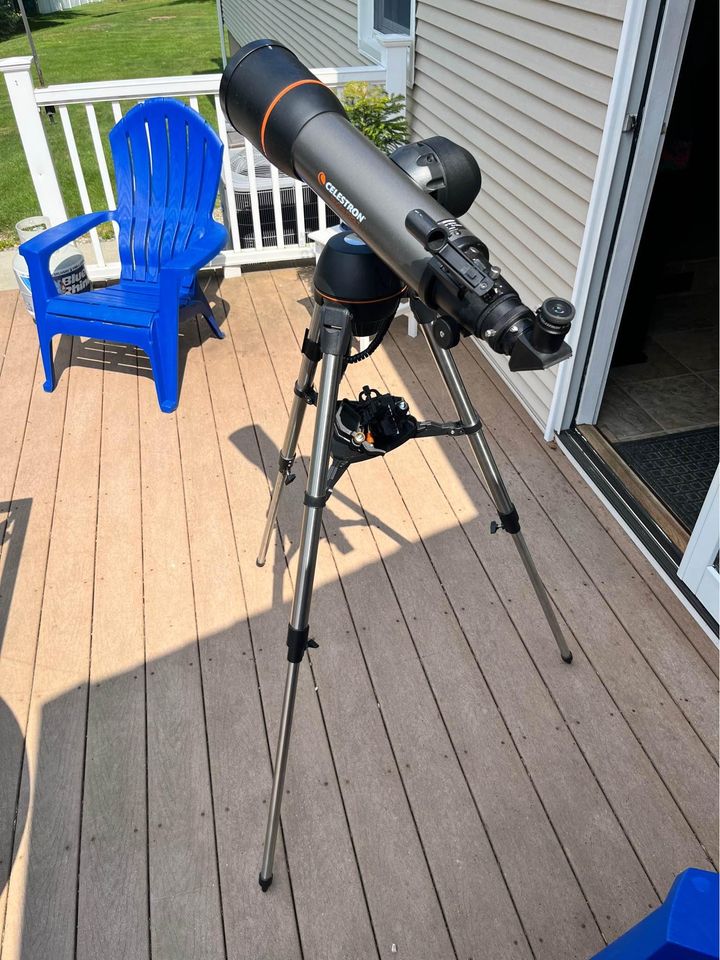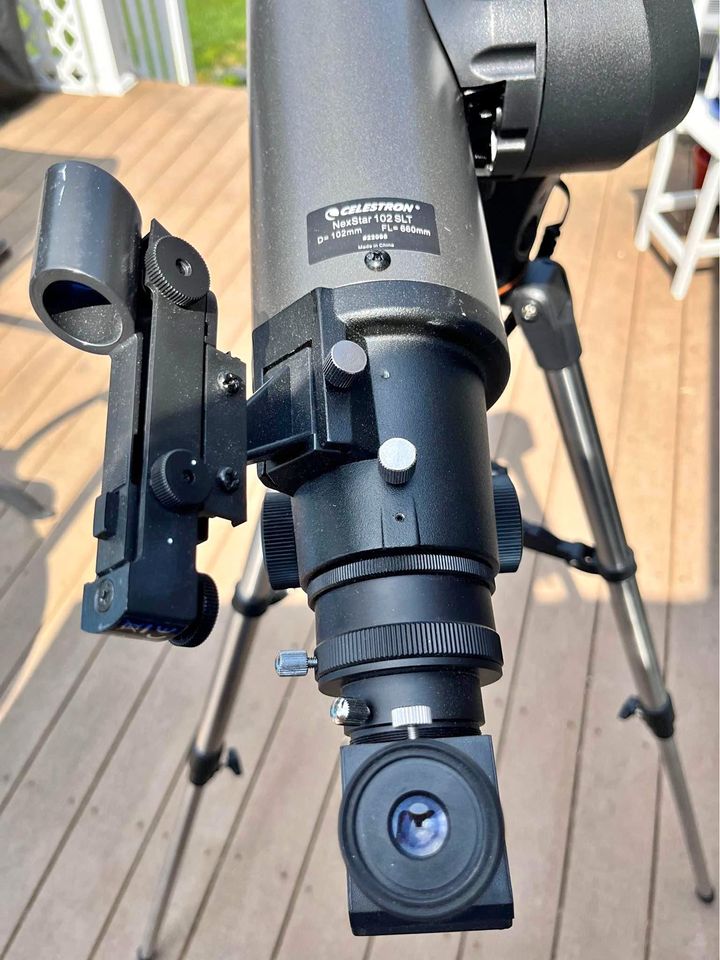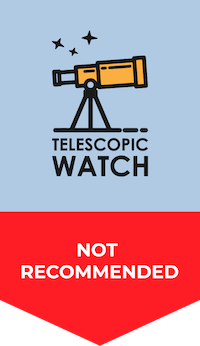The Optical Quality of the Celestron NexStar 102SLT
The Celestron NexStar 102SLT is a 102mm (4”) f/6.47 achromatic refractor, thus with a focal length of 660mm. Being a standard Fraunhofer doublet achromatic refractor with crown and flint glass lenses, the 102SLT does show chromatic aberration, or “false colour,” which is worsened by the fast f/6.47 focal ratio. But otherwise, the optical quality of the scope overall is pretty good.

The 102SLT’s dew shield is quite short, at only 3” long from the front of the lens. As a result, stray light and dew are not very well-controlled; the objective lens will fog up pretty fast on damp nights, and glare can be quite problematic, especially if you observe near a streetlight or the moon is up. You can make your own dew shield extension out of foam or a yoga mat, or buy a more rigid aftermarket plastic unit. Either way, it will significantly improve your observing experience.
The NexStar 102SLT’s focuser is a high-quality, all-metal 2” rack and pinion unit. Unfortunately, using a 2” diagonal and a wide-angle eyepiece will probably make the scope too rear-heavy to balance on the SLT mount, as the scope’s dovetail plate is short and you cannot slide it forward in the mount saddle very far. The balancing issue could be solved by putting on a longer dovetail bar and/or tube rings, but that would be problematic with the already-wobbly NexStar SLT mount.
Accessories with the 102SLT
The Celestron NexStar 102SLT comes with a StarPointer red dot finder, a 1.25” prism star diagonal, and two eyepieces: a 25mm Kellner (26x) and a 9mm Kellner (73x). Both Kellner eyepieces are mostly plastic but of decent enough quality to get you started.
A 1.25” prism diagonal is supplied with the 102SLT.

The StarPointer is the same red dot finder supplied with most inexpensive telescopes these days. While not satisfactory for star-hopping with a Dobsonian, it is just fine for its sole purpose on the SLT: aligning the GoTo system.
The Mediocre Go-To Mount
The Celestron NexStar 102SLT comes with the same Star Locating Telescope mount that all of the other SLT telescopes use—the same chassis and motors are used for Celestron’s NexStar GT, SkyProdigy and AstroFi telescopes.
The SLT mount is lightweight, using thin steel legs for the tripod. It is not what we would call stable. This is particularly so with the 102mm refractor optical tube, which is longer than any of the other telescopes supplied on the SLT mount, thus requiring the tripod legs to be extended further, decreasing stability, and creating more of a moment arm with a longer (if not that heavy) tube. With the tripod legs extended, the tripod assembly easily twists and buckles and can be knocked over by a strong breeze or an impatient child. Consequently, focusing or aiming the 102SLT at high magnifications is difficult, and keeping the computer alignment accurate for a whole night is unlikely. You could fill the legs with sand, spray foam, or pebbles and put a brick or rock on the accessory tray to try to increase stability, but filling the legs is inconvenient and time-consuming, and ultimately may not be that effective. As a result, using the 102SLT is a frustrating experience if for no other reason that keeping it pointed at something without shaking is a difficult task.
The database on the SLT scopes is variably mentioned as having either 4,000 or 40,000 deep-sky objects in its catalogue. Regardless of which it actually has, there are probably a few hundred deep-sky objects that are interesting to observe with the 102SLT.
The SLT mount is powered by 8 AA batteries, which you put into a simple pack attached to a tripod leg, which plugs into a DC power jack on the side of the mount head.
As is typical with all of Celestron’s computerised telescopes, their SkyAlign auto-alignment feature never actually works – it requires perfect time/date/location settings and perfect levelling of the tripod, a combination you are unlikely to ever achieve. Use Auto Two-Star Alignment – it’s almost as easy. Keep in mind that the time and date must be entered every time the scope is powered up, and changing location is a bit of a hassle.
Should I buy a used NexStar 102SLT?
The Celestron NexStar 102SLT’s mediocre optics and low quality mount mean it’s probably not a good idea to buy one, new or used.
Alternative Recommendations
The Celestron NexStar 102SLT’s large amount of chromatic aberration, shaky mount, and questionable mechanical design – combined with its high price and the futility of a GoTo mount for a small, wide-field scope – mean that it certainly isn’t the best option you could choose from at this price. Here are a few other scopes we recommend in its stead.
Under £550
- The StellaLyra 8”/Zhumell Z8/Orion SkyLine 8 has double the resolving power of the NexStar 102SLT, four times as much light gathering power, and optics free of chromatic aberration mounted atop a rock-solid and easy-to-aim Dobsonian base. The included accessories such as a 2” wide-angle eyepiece and 9×50 finder are of high quality and a built-in 2” dual-speed Crayford focuser and cooling fan are standard.
- The Ursa Major 8, as with the StellaLyra 8”/Z8 and similar 8” Dobsonians, features double the resolution and 4 times as much light collecting area as the NexStar 102SLT thanks to its large 8” diameter primary mirror. The Ursa Major 8 has a 2” Crayford focuser and provides great views, though it’s a little sparse on included accessories.
- The Sky-Watcher Virtuoso GTi 150P offers double the light gathering ability and 50% more resolving power than the NexStar 102SLT (though in practice, resolution is even better thanks to the 150P’s lack of chromatic aberration). The Virtuoso GTi 150P features fully motorized GoTo and tracking like the 102SLT, but it can be aimed manually and the mount is controlled via your smartphone or tablet. The Virtuoso GTi 150P’s compact form factor thanks to its collapsible tube and tabletop Dobsonian mount make it easy to store and transport and takes seconds to set up. The manual Sky-Watcher Heritage 150P is identical to the Virtuoso GTi 150P apart from lacking the GTi electronics in its mount.
- The Celestron Astro-Fi 130 is a 130mm f/5 Newtonian reflector, but is mounted atop an upgraded version of the NexStar SLT mount with thicker tripod legs and controlled via your smartphone or tablet instead of the SLT mount’s clunky and outdated hand controller keypad. The Astro-Fi 130 is probably our favorite alternative to the NexStar 102SLT if you must have a tripod.
- The Celestron Astro-Fi 102 offers slightly less light gathering power than the NexStar 102SLT and is less suitable for deep-sky viewing, but its sharp Maksutov-Cassegrain optics deliver superior views of smaller targets such as planets and double stars thanks to its lack of chromatic aberration, and the Astro-Fi mount is sturdier and more advanced than the outdated NexStar SLT mount and its spindly steel tripod.
£550-£800
- The StellaLyra 10”/Zhumell Z10/Orion SkyLine 10 features 2.5x the resolution and 6.25 times as much light gathering power as the NexStar 102SLT, mounted atop a sturdy Dobsonian mount and with the same great features and accessories as the 8” model. Compared to the StellaLyra 8”/Z8 you’re only adding a few pounds of weight and a negligible gain in length/width, so if you can afford a 10” Dob we’d heartily recommend one, particularly the AD10/Z10, over an 8” unit.
- The Celestron StarSense Explorer 8” Dobsonian is lighter and easier to transport than most other solid-tubed 8” Dobsonians thanks to its trimmed, weight-optimized base with cutouts and the handles attached to the optical tube for an easy lift. You also get Celestron’s StarSense Explorer technology to assist you in navigating the night sky using your smartphone mounted atop the telescope tube. The included accessories are, however, a little sparse, especially for the price, and you only get 8” of aperture and a single-speed 2” Crayford focuser.
- The Sky-Watcher 8” FlexTube Dobsonian takes up less space than a standard 8” or 10” Dobsonian when dismantled, so it’s good for those who put portability at a premium (though not as compact as the true trusses offered by other manufacturers like Explore Scientific). As with any 8” Dob, it blows away the NexStar 102SLT in light gathering power, resolution and overall sharpness. The included pair of eyepieces and 9×50 finder scope are decent enough. However, the Dobsonian base on this scope is not as well-designed and quite heavy compared to the competition, the open tube needs a shroud, a screwdriver is required for collimating this scope, and there’s no weight savings compared to a regular 8”.
Aftermarket Accessory Recommendations
The NexStar 102SLT is already decently equipped with a good star diagonal and pair of eyepieces, but almost any astronomer will tell you it’s good to have a collection of 3-5 eyepieces for a full range of magnifications. For instance, a 32mm Plossl eyepiece provides 20x magnification with the 102SLT and a field of view 2.6 degrees across, a bit wider of a field and lower magnification than that of the stock 25mm eyepiece. Meanwhile, a 6mm goldline or redline eyepiece delivers 108x magnification, ideal for planetary viewing and about the maximum magnification that both the NexStar 102SLT itself and its somewhat mediocre tripod can handle. If desired, you could also acquire a 15mm redline/goldline eyepiece for 43x to fit between the stock 25mm and 10mm eyepieces. These quality and cost-effective oculars will all work with other telescopes in the future thanks to the interchangeability of all 1.25” eyepieces.
A UHC nebula filter can greatly improve views of numerous nebulae, such as the Orion Nebula, with the NexStar 102SLT, and is especially helpful if you are stuck under light-polluted conditions. It’s also compatible with other telescopes in the future, in the same way as any eyepiece upgrades. While it’s not a complete solution for light pollution and is only effective on nebulae, a UHC filter is without a doubt a beneficial accessory for your astronomy equipment arsenal. This filter performs particularly well with the 102SLT under dark skies, allowing you to observe the vast North America Nebula and Veil Nebula with a suitable low-power eyepiece.
Investing in a small lithium battery power supply for the NexStar 102SLT’s mount will save you money on disposable batteries and last longer, allowing you to effortlessly run the scope for multiple observing sessions on a single charge and discard any worries about accidentally unplugging or coiling an extension cord. A generic TalentCell lithium power bank strapped to one of the tripod legs or the more expensive but durable Celestron PowerTank Lithium will do.
What can you see with the Celestron Nexstar 102SLT?
Being a 4” refractor, the 102SLT has enough aperture to show a fair number of nebulae, star clusters, and galaxies. However, the wide field of view means that the GoTo system is kind of unnecessary to find many of them. Furthermore, you can’t move the scope manually, and half the fun of a wide-field refractor is panning around the Milky Way and star fields, which you can’t really do with this telescope. Globular clusters will lack resolution, while most galaxies are too dim to see with the 102SLT’s small aperture, particularly under light-polluted skies. Open star clusters and large nebulae like the Veil, Swan, and Lagoon are the main treats with this telescope.
The Moon and planets look good with the 102SLT as well, provided you can get the scope to stop shaking. Jupiter’s cloud belts, Great Red Spot, and 4 brightest moons can be seen, and Saturn’s rings are visible along with a handful of moons. You might have trouble seeing much in the way of detail on Mars, even at opposition, due to the 102SLT’s chromatic aberration smearing out the planet’s red disk. Uranus and Neptune are little more than starlike dots, while Venus and Mercury’s phases are visible (albeit barely with the latter due to its small size).
Not for Astrophotography
The alt-azimuth nature and cheap gears of the SLT mount, combined with the inability to balance with heavy accessories and, of course, chromatic aberration, means that serious astrophotography, be it deep-sky or lunar/planetary imaging, is pretty much out of the question with the NexStar 102SLT. You can have some fun shooting the Moon with a phone adapter such as Celestron’s NexYZ (which they offer bundled with the telescope), but that is about the limit of the telescope’s capabilities.


